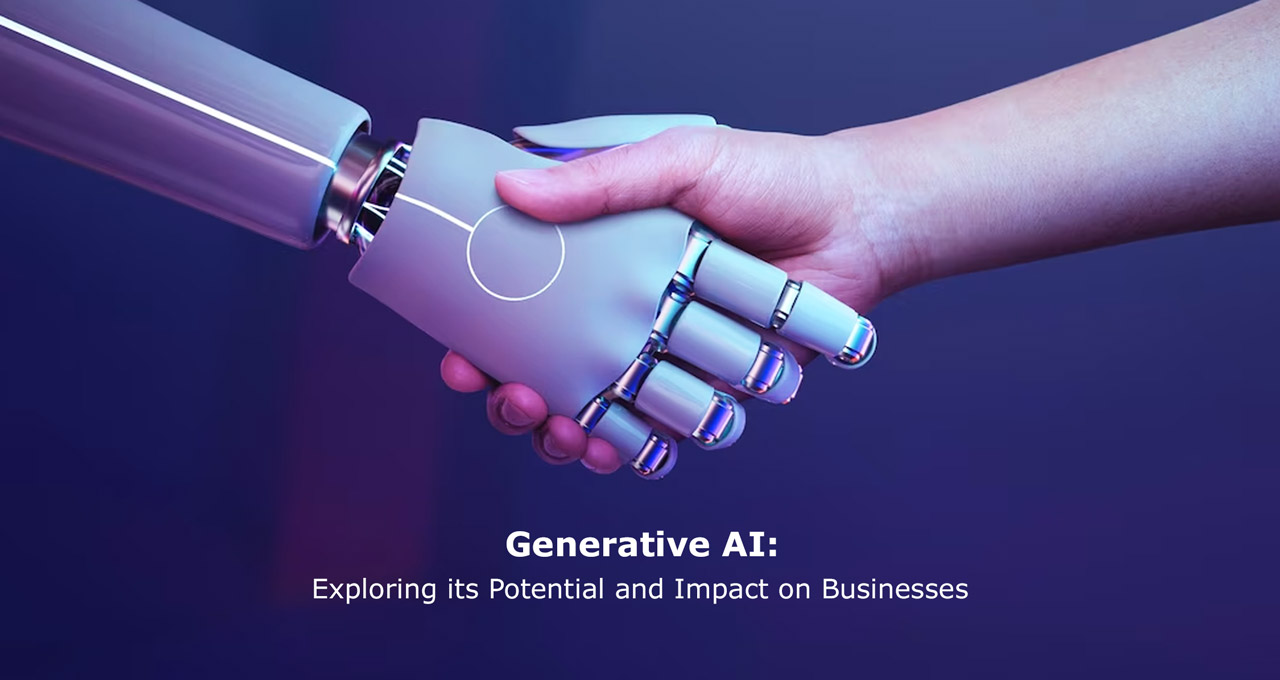
Image Credit: Image by rawpixel.com on Freepik
In today’s fast-paced world, the field of artificial intelligence (AI) continues to push boundaries and reshape industries. One area that has gained significant attention is Generative AI, a powerful technology that holds immense potential for businesses. In this blog post, we will delve into the concept of Generative AI, its workings, and how it is revolutionizing industries. We will also explore the benefits of implementing Generative AI, examine different types of applications and services available in the market, discuss its future, and understand its impact on businesses and consumers alike.
What is Generative AI and How Does it Work?
Generative AI operates by utilizing deep learning techniques to analyze and understand patterns and structures within existing data. Through this process, it can generate new content that closely resembles the original data. The underlying models of generative AI learn from large datasets, allowing them to generate coherent and contextually appropriate outputs.
Generative AI models can take various forms, including Generative Adversarial Networks (GANs), Variational AutoEncoders (VAEs), and Recurrent Neural Networks (RNNs). These models are trained on massive amounts of data, such as text, images, or audio, to learn the underlying patterns and generate new content.
GANs, for example, consist of two neural networks: a generator and a discriminator. The generator network generates new samples based on the patterns it learns from the training data. Simultaneously, the discriminator network aims to distinguish between the generated samples and real data. Through an iterative process, both networks improve their performance, leading to the generation of more realistic and high-quality content.
Generative AI techniques have proven to be highly successful in various domains. Natural language generation (NLG) models, for instance, can generate coherent and contextually appropriate text, making them useful for applications such as chatbots, automated content generation, and language translation.
Image generation models, on the other hand, can generate realistic images based on the patterns and features they learn from large image datasets. This capability has found applications in areas such as computer vision, design, and entertainment.
Overall, generative AI models possess the ability to learn and capture complex patterns from existing data, enabling them to create new content that aligns with the style and characteristics of the original dataset.
How Generative AI is Revolutionizing Industries
Generative AI is driving a significant revolution across a wide range of industries, empowering businesses with innovative solutions and transforming traditional practices. Let’s explore some key areas where generative AI is making a remarkable impact:
Healthcare
In the healthcare industry, generative AI is revolutionizing medical imaging analysis, drug discovery, and personalized medicine. Generative models can generate synthetic medical images to augment limited datasets, aiding in accurate diagnosis and treatment planning. Additionally, generative AI can assist in the development of new drugs by generating novel molecular structures and predicting their properties, expediting the process of drug discovery.
Finance
The finance industry is leveraging generative AI for tasks such as fraud detection, risk assessment, and algorithmic trading. Generative models can identify patterns and anomalies in financial data, enabling early detection of fraudulent activities. Moreover, generative AI can simulate market scenarios and generate synthetic data to train trading algorithms, enhancing decision-making and optimizing investment strategies.
Marketing
Generative AI is transforming marketing by enabling personalized content creation, customer segmentation, and recommendation systems. Marketers can utilize generative models to generate engaging and tailored content for specific target audiences, enhancing customer engagement and driving conversions. Furthermore, generative AI techniques can analyze customer behavior and preferences to create personalized product recommendations, enhancing the overall customer experience.
Entertainment
The entertainment industry is embracing generative AI to enhance the creation of visual effects, virtual reality experiences, and computer-generated imagery. Generative models can generate realistic and immersive environments, characters, and special effects, enabling filmmakers and game developers to push the boundaries of creativity and storytelling.
Manufacturing
In manufacturing, generative AI is optimizing production processes, quality control, and product design. Generative models can generate optimized designs based on specific parameters and constraints, leading to the creation of lighter, stronger, and more efficient products. Additionally, generative AI can analyze sensor data to detect anomalies and predict equipment failures, enabling proactive maintenance and reducing downtime.
The Benefits of Implementing Generative AI
Implementing generative AI models brings a multitude of benefits to businesses. Let’s delve into some of the advantages and advantages of leveraging generative AI:
Improved Creativity
Generative AI models have the ability to generate novel and creative content. They can produce unique designs, artworks, and written material, which can serve as inspiration for creative professionals in fields such as design, advertising, and content creation. By augmenting human creativity, generative AI opens up new possibilities for innovative and captivating content creation.
Enhanced Personalization
Generative AI enables businesses to deliver personalized experiences to their customers. By analyzing large volumes of data, generative models can generate personalized recommendations, product suggestions, and tailored content based on individual preferences and behavior. This level of personalization not only improves customer satisfaction but also boosts engagement and drives conversions.
Increased Productivity
Generative AI automates repetitive and time-consuming tasks, freeing up valuable human resources for more complex and strategic activities. For instance, in content generation, generative models can assist in automatically creating blog posts, social media content, and product descriptions, reducing the burden on content creators and marketers. By streamlining workflows and automating mundane tasks, generative AI enhances productivity and allows businesses to focus on higher-value activities.
Advanced Decision-making
Generative AI models can provide valuable insights and support decision-making processes. By analyzing data and generating predictive models, generative AI can help businesses identify trends, anticipate market changes, and make informed decisions. For example, in demand forecasting, generative models can generate future sales predictions based on historical data, enabling businesses to optimize inventory management and supply chain operations.
Efficient Resource Utilization
Generative AI models optimize resource utilization by generating synthetic data. In scenarios where data is scarce or expensive to collect, generative models can generate synthetic samples that mimic the characteristics of the real data. This synthetic data can then be used to train machine learning models, reducing the dependence on large, costly datasets and enabling businesses to make the most of limited resources.
Exploring Different Types of Generative AI Applications & Services in the Market
The market is brimming with a variety of generative AI applications and services, catering to different domains and use cases. Let’s explore some popular examples across different application areas:
Machine Translation
Generative AI has revolutionized the field of language translation. Neural machine translation models, powered by generative AI, can accurately translate text between multiple languages. Prominent examples include Google Translate, Microsoft Translator, and DeepL, which utilize generative models to deliver high-quality translations, enabling seamless communication across borders and languages.
Natural Language Processing (NLP)
Generative AI plays a vital role in NLP applications such as chatbots, virtual assistants, and automated content generation. OpenAI’s GPT models, including GPT-3 and GPT-4, are leading examples of generative models that excel in natural language understanding and generation. These models can generate coherent and contextually appropriate responses, powering intelligent conversational agents and automated content creation.
Image Generation
Generative AI has transformed image recognition and analysis. Deep learning models like generative adversarial networks (GANs) have enabled advancements in areas such as image synthesis, style transfer, and image-to-image translation. Popular tools like Midjourney and DALL-E 2 demonstrate the power of generative AI in generating realistic images, transforming images in various styles, and even reconstructing images from incomplete or damaged samples.
Music Generation
Generative AI has found applications in music generation and composition. Tools like OpenAI’s MuseNet and Jukedeck offer AI-powered music composition services. These generative models can generate original musical compositions in various genres, styles, and moods, assisting musicians, content creators, and media professionals in generating royalty-free music tracks.
Design and Creativity
Generative AI is also making an impact in design-related domains. Tools such as Runway ML and Adobe Firefly leverage generative models to facilitate creative exploration and generate unique designs and visual artworks. These tools enable designers and artists to experiment with different styles, generate novel compositions, and push the boundaries of creative expression.
These examples represent a snapshot of the diverse generative AI applications available in the market. As the field continues to advance, we can expect more innovative applications and services to emerge, unlocking new possibilities across industries.
The Future of Generative AI & How It Will Impact Businesses and Consumers Alike
Generative AI is poised to have a profound impact on businesses and consumers in the future, opening up new possibilities and transforming various aspects of our lives. Here are some key factors that will shape the future of generative AI:
Advancements in Model Capabilities
Generative AI models are constantly evolving and becoming more sophisticated. As researchers and developers continue to push the boundaries, we can expect generative models to generate even more realistic and high-fidelity outputs. This will enable businesses to create compelling content, immersive experiences, and personalized solutions that closely align with individual preferences and needs.
Ethical Considerations
As generative AI becomes more prevalent, ethical considerations will play a crucial role. Issues such as data privacy, bias in generated content, and responsible use of AI will need to be addressed. Businesses will need to ensure transparency, fairness, and accountability in the development and deployment of generative AI models to build trust with consumers and avoid unintended consequences.
Enhanced Human-AI Collaboration
The future of generative AI lies in leveraging the strengths of both humans and AI. Generative models can assist humans in creative tasks, providing inspiration and generating initial ideas that can be further refined by human experts. This collaboration between humans and AI will lead to increased productivity, innovation, and novel solutions.
Customization and Personalization
Generative AI will enable businesses to offer highly customized and personalized experiences to consumers. From tailored products and services to personalized recommendations and content, generative AI will allow businesses to deliver offerings that cater to individual preferences, resulting in enhanced customer satisfaction and loyalty.
Democratization of AI
The future will likely witness the democratization of generative AI, with increased accessibility and user-friendly tools. As AI technologies become more user-friendly and accessible, businesses of all sizes will be able to leverage generative AI to drive innovation, enhance customer experiences, and gain a competitive edge.
Conclusion
Generative AI has emerged as a game-changer, revolutionizing the way businesses operate and interact with consumers. Its ability to create new content and generate valuable insights opens up a world of opportunities.
As the technology continues to advance, it is crucial for businesses to stay informed and embrace the potential of generative AI. By harnessing its power, businesses can unlock new opportunities, enhance their operations, and create meaningful connections with consumers.

